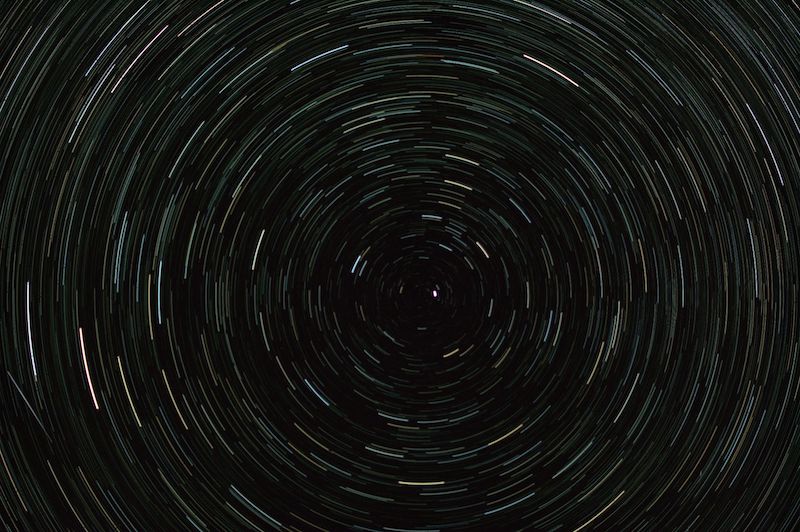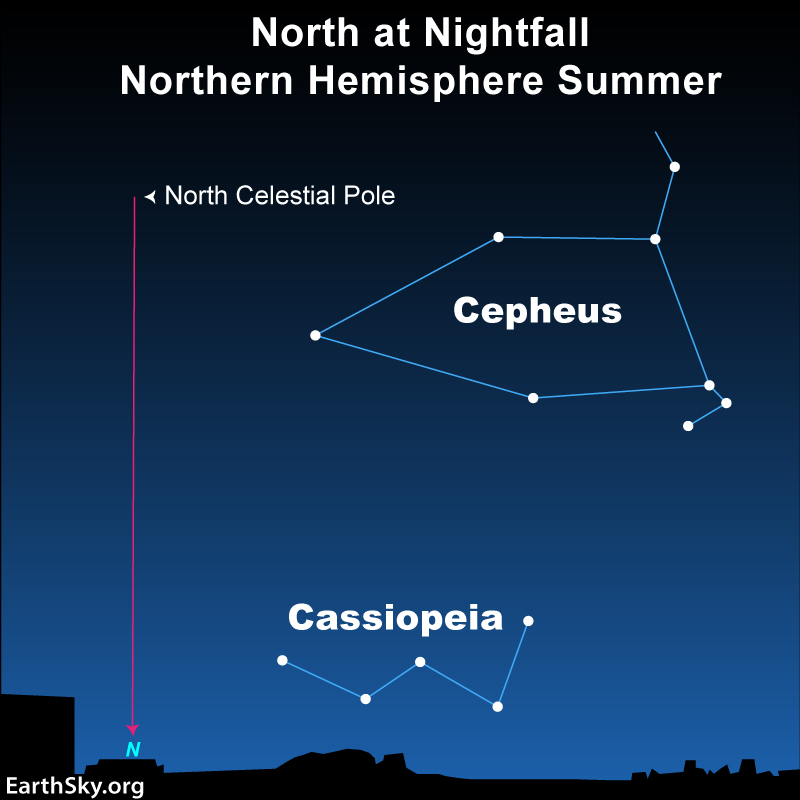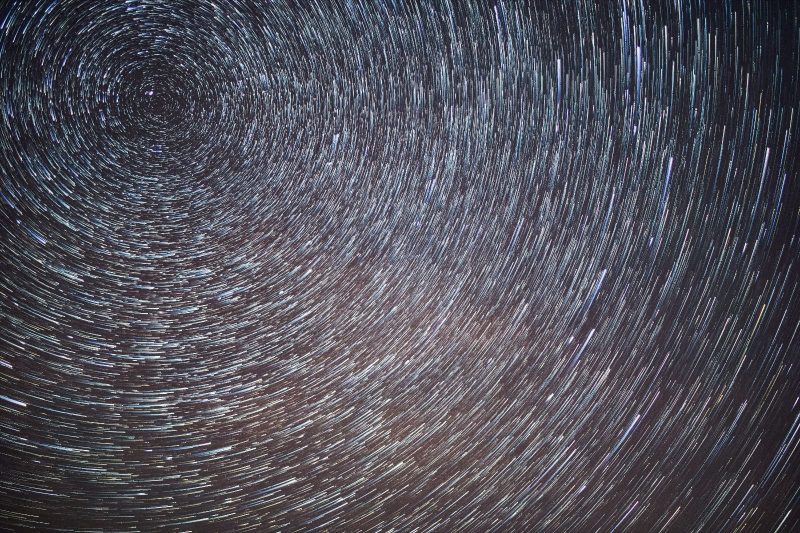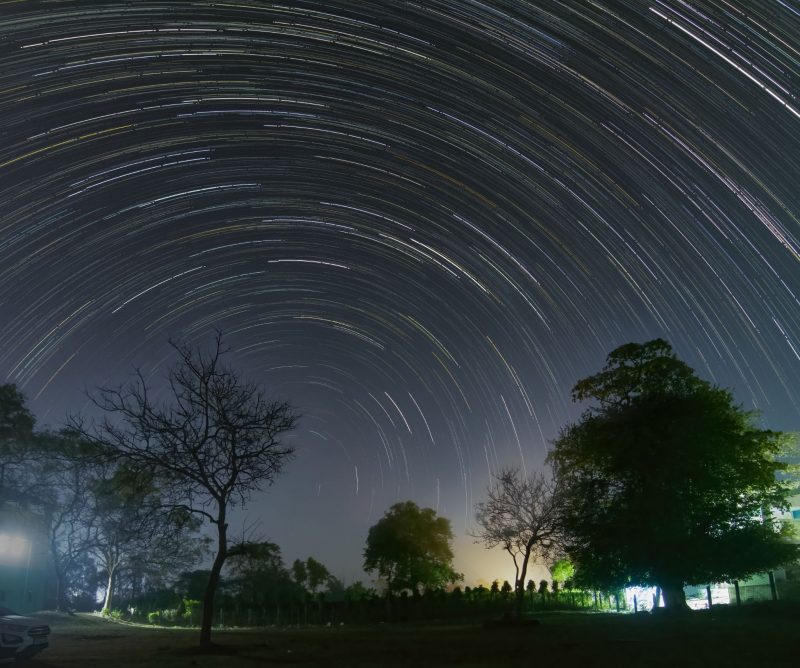
Circumpolar stars circle the celestial pole
The closer you are to either of Earth’s poles, the more circumpolar stars you see. Circumpolar stars neither rise nor set but stay above the horizon at all hours of the day, every day of the year. Even when you can’t see them – when the sun is out and it’s daytime – these stars are up there. They are circling endlessly around the sky’s north or south celestial pole.
For instance, the stars of the famous Big Dipper asterism are circumpolar at all latitudes north of 41 degrees north latitude, which includes the northern half of the mainland United States and most of Europe.
No circumpolar stars at Earth’s equator
How many circumpolar stars appear in your sky depends on where you are. At Earth’s North and South Poles, every visible star is circumpolar. That is, at Earth’s North Pole, every star north of the celestial equator is circumpolar, while every star south of the celestial equator stays below the horizon. At the Earth’s South Pole, it’s the exact opposite. Every star south of the celestial equator is circumpolar, whereas every star north of the celestial equator remains beneath the horizon.
At the Earth’s equator, no star is circumpolar because all the stars rise and set daily in that part of the world. You can (theoretically) see every star in the night sky over the course of one year. In practice, of course, things like clouds and horizon haze get in the way.
Circumpolar stars and where you live
Places between the equator and poles have some stars that are circumpolar, some stars that rise and set daily (like the sun), and some stars that remain below the horizon all year round. In short, the closer you are to the North or South Pole, the greater the circle of circumpolar stars; the closer you are to the Earth’s equator, the smaller the circle of circumpolar stars.
Here is how to determine what is circumpolar from your location. Subtract your latitude from 90 and you get the declination of the objects that barely skim above your northern (or southern) horizon. For instance, from a latitude of 40° north, everything north of a declination of +50° is circumpolar. From the Southern Hemisphere, at a latitude of 20° south, then everything south of -70° declination is circumpolar, above your southern horizon.
We in the Northern Hemisphere are lucky to have a moderately bright star, Polaris, nearly coinciding with the north celestial pole: the point in the sky that’s at zenith (straight overhead) at the Earth’s North Pole.
Polaris at center of circle
Draw an imaginary line straight down from Polaris, the North Star, to the horizon, and presto, you have what it takes to draw out the circle of circumpolar stars in your sky.

For people in the Northern Hemisphere, Polaris nearly pinpoints the center of the great big circle of circumpolar stars on the sky’s dome; and the imaginary vertical line from Polaris to the horizon depicts the radius measure. (See the above chart, which has this line drawn in for you.)
Let your arm serve as a circle compass, enabling you to envision the circle of circumpolar stars with your mind’s eye. Closer to the equator, the circle of circumpolar stars grows smaller; nearer to the North Pole (or South Pole) the circle of circumpolar stars grows larger.
Circumpolar stars in Southern Hemisphere
This technique for locating the circle of circumpolar stars works in the Southern Hemisphere, as well. However, it’s trickier to star-hop to the south celestial pole: the point on the sky’s dome that’s at zenith over the Earth’s South Pole. Practiced stargazers in the Southern Hemisphere rely on the Southern Cross, and key stars, to star-hop to the south celestial pole.
The Southern Cross is circumpolar anywhere south of 35 degrees south latitude; yet, in the Northern Hemisphere, it’s the W or M-shaped constellation Cassiopeia that’s circumpolar at all places north of 35 degrees north latitude.
Polaris and Cassiopeia
By the way, Cassiopeia lies on the opposite side of Polaris from the Big Dipper. So from mid-northern latitudes, the Big Dipper and Polaris help you to locate Cassiopeia.
If Cassiopeia is circumpolar in your sky, then the Southern Cross never climbs above your horizon. Conversely, if the Southern Cross is circumpolar in your sky, then the constellation Cassiopeia never climbs above the horizon.
As seen from the tropics (and a part of the subtropics), neither the Southern Cross nor Cassiopeia is circumpolar. From this part of the world, the Southern Cross rises over the southern horizon when Cassiopeia sinks below the northern horizon. Conversely, Cassiopeia rises over the northern horizon when the Southern Cross sinks below the southern horizon.
Circumpolar star trail gallery


Steve Torrence made this video of circumpolar stars from near the equator on June 21, 2016. Video via Wikimedia Commons.
Bottom line: Circumpolar stars stay above the horizon all hours of the day, every day of the year. Although you can’t see them, they’re up even in the daytime.
Read more: Use the Southern Cross to find due south
The post Circumpolar stars never rise or set and depend on latitude first appeared on EarthSky.
from EarthSky https://ift.tt/awHjgVD

Circumpolar stars circle the celestial pole
The closer you are to either of Earth’s poles, the more circumpolar stars you see. Circumpolar stars neither rise nor set but stay above the horizon at all hours of the day, every day of the year. Even when you can’t see them – when the sun is out and it’s daytime – these stars are up there. They are circling endlessly around the sky’s north or south celestial pole.
For instance, the stars of the famous Big Dipper asterism are circumpolar at all latitudes north of 41 degrees north latitude, which includes the northern half of the mainland United States and most of Europe.
No circumpolar stars at Earth’s equator
How many circumpolar stars appear in your sky depends on where you are. At Earth’s North and South Poles, every visible star is circumpolar. That is, at Earth’s North Pole, every star north of the celestial equator is circumpolar, while every star south of the celestial equator stays below the horizon. At the Earth’s South Pole, it’s the exact opposite. Every star south of the celestial equator is circumpolar, whereas every star north of the celestial equator remains beneath the horizon.
At the Earth’s equator, no star is circumpolar because all the stars rise and set daily in that part of the world. You can (theoretically) see every star in the night sky over the course of one year. In practice, of course, things like clouds and horizon haze get in the way.
Circumpolar stars and where you live
Places between the equator and poles have some stars that are circumpolar, some stars that rise and set daily (like the sun), and some stars that remain below the horizon all year round. In short, the closer you are to the North or South Pole, the greater the circle of circumpolar stars; the closer you are to the Earth’s equator, the smaller the circle of circumpolar stars.
Here is how to determine what is circumpolar from your location. Subtract your latitude from 90 and you get the declination of the objects that barely skim above your northern (or southern) horizon. For instance, from a latitude of 40° north, everything north of a declination of +50° is circumpolar. From the Southern Hemisphere, at a latitude of 20° south, then everything south of -70° declination is circumpolar, above your southern horizon.
We in the Northern Hemisphere are lucky to have a moderately bright star, Polaris, nearly coinciding with the north celestial pole: the point in the sky that’s at zenith (straight overhead) at the Earth’s North Pole.
Polaris at center of circle
Draw an imaginary line straight down from Polaris, the North Star, to the horizon, and presto, you have what it takes to draw out the circle of circumpolar stars in your sky.

For people in the Northern Hemisphere, Polaris nearly pinpoints the center of the great big circle of circumpolar stars on the sky’s dome; and the imaginary vertical line from Polaris to the horizon depicts the radius measure. (See the above chart, which has this line drawn in for you.)
Let your arm serve as a circle compass, enabling you to envision the circle of circumpolar stars with your mind’s eye. Closer to the equator, the circle of circumpolar stars grows smaller; nearer to the North Pole (or South Pole) the circle of circumpolar stars grows larger.
Circumpolar stars in Southern Hemisphere
This technique for locating the circle of circumpolar stars works in the Southern Hemisphere, as well. However, it’s trickier to star-hop to the south celestial pole: the point on the sky’s dome that’s at zenith over the Earth’s South Pole. Practiced stargazers in the Southern Hemisphere rely on the Southern Cross, and key stars, to star-hop to the south celestial pole.
The Southern Cross is circumpolar anywhere south of 35 degrees south latitude; yet, in the Northern Hemisphere, it’s the W or M-shaped constellation Cassiopeia that’s circumpolar at all places north of 35 degrees north latitude.
Polaris and Cassiopeia
By the way, Cassiopeia lies on the opposite side of Polaris from the Big Dipper. So from mid-northern latitudes, the Big Dipper and Polaris help you to locate Cassiopeia.
If Cassiopeia is circumpolar in your sky, then the Southern Cross never climbs above your horizon. Conversely, if the Southern Cross is circumpolar in your sky, then the constellation Cassiopeia never climbs above the horizon.
As seen from the tropics (and a part of the subtropics), neither the Southern Cross nor Cassiopeia is circumpolar. From this part of the world, the Southern Cross rises over the southern horizon when Cassiopeia sinks below the northern horizon. Conversely, Cassiopeia rises over the northern horizon when the Southern Cross sinks below the southern horizon.
Circumpolar star trail gallery


Steve Torrence made this video of circumpolar stars from near the equator on June 21, 2016. Video via Wikimedia Commons.
Bottom line: Circumpolar stars stay above the horizon all hours of the day, every day of the year. Although you can’t see them, they’re up even in the daytime.
Read more: Use the Southern Cross to find due south
The post Circumpolar stars never rise or set and depend on latitude first appeared on EarthSky.
from EarthSky https://ift.tt/awHjgVD

Aucun commentaire:
Enregistrer un commentaire